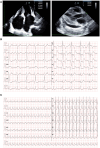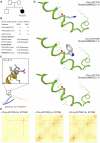Challenging of ECMO application in pediatric restrictive cardiomyopathy: case report of a novel TNNI3 variant
- PMID: 38854656
- PMCID: PMC11157066
- DOI: 10.3389/fcvm.2024.1365209
Challenging of ECMO application in pediatric restrictive cardiomyopathy: case report of a novel TNNI3 variant
Abstract
Background: Restrictive cardiomyopathy (RCM) represents a rare cardiovascular disorder stemming from filament-associated genes. Nonetheless, treating RCM presents considerable challenges, particularly concerning device implantation and mechanical support. Furthermore, elucidating the molecular function of specific variants holds promise in benefiting patients and enhancing prognosis, given the significant heterogeneity among RCM variants.
Case presentation: The proband, an eight-year-old female, was admitted to our hospital post cardiopulmonary resuscitation due to sudden cardiac arrest. Echocardiography revealed bilateral atrial enlargement. Whole-exome sequencing uncovered a novel heterozygous mutation (c.509G>A, p.R170Q) in TNNI3. Evaluation using the MutationTaster application deemed c.509G>A pathogenic (probability = 0.99). Following clinical manifestations, imaging assessments, and genetic screening, the proband received an RCM diagnosis. ECMO was recommended along with continuous renal replacement therapy. However, persistent atrial flutter ensued post-ECMO withdrawal. Attempts to restore cardiac rhythm with cardioversion, metoprolol, and amiodarone proved futile. Subsequent heart failure led to the patient's demise due to cardiac shock. Based on crystal protein structural analysis, we observed that cTnI-R170Q and R170W exerted similar impacts on protein structural stability and formation. However, both differed significantly from cTnI-R170G, primarily influencing amino acid regions 32-79 and 129-149, involved in TnC and actin binding. Therefore, cTnI-R170Q was revealed to induce RCM via the same molecular mechanism as cTnI-R170W.
Conclusion: Managing RCM remains a critical challenge. This study underscores the discouragement of device implantations for cardiac pump functional support in RCM, particularly for non-short-term scheduled HTx. Additionally, considering catheter ablation for atrial fibrosis-induced AFs is recommended. Mechanistically, cTnI-R170Q primarily diminishes troponin-actin interactions and destabilizes thin filaments.
Keywords: ECMO; TNNI3; heart failure; heart transplantation; restrictive cardiomyopathy.
© 2024 Jin, Xu, Hua, Zhang and Li.
Conflict of interest statement
The authors declare that the research was conducted in the absence of any commercial or financial relationships that could be construed as a potential conflict of interest.
Figures


Similar articles
-
Infantile restrictive cardiomyopathy: cTnI-R170G/W impair the interplay of sarcomeric proteins and the integrity of thin filaments.PLoS One. 2020 Mar 17;15(3):e0229227. doi: 10.1371/journal.pone.0229227. eCollection 2020. PLoS One. 2020. PMID: 32182250 Free PMC article.
-
[Genetic analysis of a child with restricted cardiomyopathy and phenylketonuria and a literature review].Zhonghua Yi Xue Yi Chuan Xue Za Zhi. 2023 Aug 10;40(8):990-997. doi: 10.3760/cma.j.cn511374-202200909-00615. Zhonghua Yi Xue Yi Chuan Xue Za Zhi. 2023. PMID: 37532500 Review. Chinese.
-
Impaired Relaxation in Induced Pluripotent Stem Cell-Derived Cardiomyocytes with Pathogenic TNNI3 Mutation of Pediatric Restrictive Cardiomyopathy.J Am Heart Assoc. 2024 Mar 19;13(6):e032375. doi: 10.1161/JAHA.123.032375. Epub 2024 Mar 18. J Am Heart Assoc. 2024. PMID: 38497452 Free PMC article.
-
Case Report: Restrictive cardiomyopathy due to a rare mutation in troponin I gene (TNNI3) in a patient.Front Cardiovasc Med. 2024 Nov 20;11:1456542. doi: 10.3389/fcvm.2024.1456542. eCollection 2024. Front Cardiovasc Med. 2024. PMID: 39635265 Free PMC article.
-
Restrictive cardiomyopathy: from genetics and clinical overview to animal modeling.Rev Cardiovasc Med. 2022 Mar 17;23(3):108. doi: 10.31083/j.rcm2303108. Rev Cardiovasc Med. 2022. PMID: 35345275 Review.
References
Publication types
LinkOut - more resources
Full Text Sources
Research Materials
Miscellaneous

